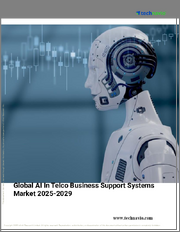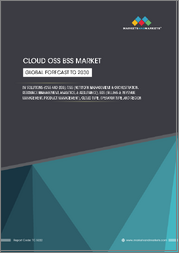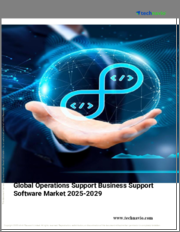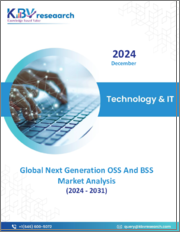
|
시장보고서
상품코드
1744553
세계의 차세대 OSS 및 BSS 시장 : 시장 예측 - 아키텍처 유형별, 네트워크별, 지역별 분석(-2032년)Next Generation OSS & BSS Market Forecasts to 2032 - Global Analysis By Architecture Type (Revenue management, Service fulfilment, Customer management, Account management and Network management systems), Network and By Geography |
||||||
Stratistics MRC에 따르면 세계의 차세대 OSS 및 BSS 시장은 2025년에 763억 달러로 추정되고, 예측 기간 중 CAGR은 15.3%로 성장할 전망이며, 2032년에는 2,067억 달러에 달할 것으로 예측되고 있습니다.
차세대 OSS(운영지원시스템) 및 BSS(업무지원시스템)는 통신업무 및 비즈니스 프로세스를 최적화 및 자동화하기 위해 고안된 고급 통합 프레임워크를 말합니다. 이러한 시스템은 클라우드 기술, 인공지능, 데이터 분석을 활용하여 서비스 제공 강화, 고객 경험 향상, 네트워크 관리 합리화를 실현합니다. 차세대 OSS는 네트워크의 자동화, 장애관리, 실시간 모니터링에 중점을 두고 BSS는 과금, 수익관리, 서비스 보증 등의 고객용 기능을 취급한다. 이들을 조합함으로써 통신 사업자는 복잡한 네트워크를 효율적으로 관리하고 운영 비용을 절감하며 디지털 퍼스트 환경에서 새로운 서비스의 신속한 전개를 지원할 수 있습니다.
통신 업계의 디지털 전환
통신 업계의 디지털 전환은 차세대 OSS(운용 지원 시스템) 및 BSS(업무 지원 시스템) 시장에 혁명을 가져오고 있습니다. AI, 기계 학습, 자동화를 통합함으로써 통신사는 네트워크 관리, 고객 체험, 업무 효율을 개선하고 있습니다. 이러한 변혁을 통해 서비스 제공의 신속화, 데이터 분석의 강화, 민첩성의 향상이 촉진되어 통신 사업자는 개인화된 실시간 서비스를 제공할 수 있게 됩니다. 그 결과 시장에서는 기술 혁신, 비용 절감, 확장성 강화가 진행되어 보다 경쟁력 있고 신속한 통신 솔루션으로의 길이 열립니다.
높은 도입 비용
차세대 OSS 및 BSS 시장에서는 도입 비용이 높고, 특히 중소기업에 있어서는 도입을 방해할 수 있습니다. 이러한 비용은 선진 시스템으로의 업그레이드를 억제하고 혁신 및 효율성 향상을 제한할 가능성이 있습니다. 또한 경제적 부담은 프로젝트 지연, ROI 저하, 복잡성 증대를 초래하여 최종적으로 시장 전체의 성장과 개척을 방해하게 됩니다.
실시간 분석 및 인사이트 수요
실시간 분석 및 인사이트에 대한 수요 증가는 차세대 OSS(운용지원시스템) 및 BSS(업무지원시스템) 시장을 크게 변화시키고 있습니다. 사업자가 데이터에 기반한 의사결정을 즉시 할 수 있도록 함으로써 업무 효율, 고객 체험, 수익 창출이 개선됩니다. 실시간 분석을 통해 네트워크 성능 감시, 리소스 배분 최적화, 서비스 개인화가 가능해집니다. 그 결과, OSS와 BSS 솔루션은 고도의 분석, AI, 자동화를 통합하도록 진화해, 통신 업계의 혁신 및 경쟁력을 촉진하고 있습니다.
레거시 시스템과의 복잡한 통합
레거시 시스템과의 복잡한 통합은 차세대 OSS 및 BSS 시장에 있어서 큰 과제가 되고 있습니다. 그것은 민첩성을 방해하고, 운용 비용을 증가시키며, 새로운 서비스 시장 투입까지의 시간을 늦춥니다. 레거시 시스템은 최신 기술과 호환되지 않는 경우가 많아 통합이 복잡하고 리소스 집약적이 됩니다. 그 결과 비효율, 보안 위험, 확장성 제한을 초래하고 궁극적으로 빠르게 진화하는 통신 환경 속에서 서비스 공급자가 혁신을 일으켜 경쟁력을 유지하는 능력을 방해하고 있습니다.
COVID-19의 영향
COVID-19의 대유행은 차세대 OSS(운영지원시스템) 및 BSS(업무지원시스템) 솔루션의 채용을 크게 가속화했습니다. 원격근무, 디지털 전환, 온라인 서비스에 대한 수요가 증가함에 따라 통신사업자는 클라우드 기반의 애자일에서 자동화된 시스템으로 눈을 돌렸습니다. 이러한 기술에 의해, 서비스 제공의 신속화, 코스트 효율화, 고객 체험의 향상이 가능해져, 시장의 성장을 견인하고 있습니다. 디지털 생태계로의 전환은 팬데믹 이후에도 계속되어 통신 업계를 재형성할 것으로 예상됩니다.
예측 기간 중 고정 및 무선 분야가 최대가 될 전망
고정 및 무선 분야는 통신 사업자의 네트워크 관리의 합리화, 서비스 제공의 개선, 고객 경험의 향상을 가능하게 하기 위해, 예측 기간 중에 최대 시장 점유율을 차지할 것으로 예측됩니다. 고도의 연결성에 대한 수요 증가, IoT 및 5G 기술의 부상으로 차세대 OSS 및 BSS 솔루션은 민첩성, 확장성, 실시간 인사이트를 제공합니다. 이것에 의해, 운용 효율의 향상, 비용 삭감, 혁신의 서포트가 가능해져, 고정 및 무선의 양 영역에서 시장 확대에 한층 더 박차를 가합니다.
예측 기간 동안 고객 관리 분야의 CAGR이 가장 높아질 전망
예측 기간 동안 고객 관리 분야는 고객 경험, 개인화, 업무 효율성을 높이기 위해 가장 높은 성장률을 나타낼 것으로 예측됩니다. 고도의 분석, AI 주도 인사이트, 자동화를 통해 통신 사업자는 서비스 제공 최적화, 고객 유지 개선, 청구 프로세스 합리화를 실현할 수 있습니다. 이러한 변혁을 통해 새로운 서비스의 시장 투입까지의 시간이 단축되고, 운용 비용이 절감되며, 고객 만족도가 향상되어, 고객 관리 부문은 진화하는 통신 정세에서의 성장 및 혁신을 실현하는 중요한 수단으로 자리 잡게 됩니다.
최대 점유율을 차지하는 지역 :
예측 기간 동안 통신 인프라 및 서비스 제공의 진보로 아시아태평양이 최대 시장 점유율을 차지할 것으로 예측됩니다. 통신 사업자가 프로세스를 자동화하고 고객 경험을 향상시키며 업무 효율을 개선할 수 있도록 함으로써 이러한 시스템은 확장성과 유연성 향상에 기여합니다. AI, 5G, 클라우드 컴퓨팅 등 차세대 기술의 채택은 혁신을 더욱 뒷받침하고 네트워크 관리와 수익 창출을 최적화합니다. 이 변혁에 의해, 아시아태평양 지역은 세계의 전기 통신의 진보에 있어서 중요한 기업으로서 자리매김하고 있습니다.
CAGR이 가장 높은 지역 :
예측 기간 동안 북미는 자동화, 실시간 분석 및 고객 경험 향상에 대한 수요 증가로 가장 높은 CAGR을 나타낼 것으로 예측됩니다. AI, 5G, IoT와 같은 선진 기술은 통신 및 IT 운영에 혁명을 가져오고 있습니다. 이러한 시스템을 통해 서비스 공급자는 프로세스를 합리화하고 비용을 절감하며 서비스 제공을 강화할 수 있습니다. 확장성 및 민첩성에 초점을 맞춘 차세대 OSS 및 BSS 솔루션은 이 지역 통신의 미래를 형성하고 혁신과 효율성을 촉진하고 있습니다.
무료 맞춤형 서비스
이 보고서를 구독하는 고객은 다음 무료 맞춤설정 옵션 중 하나를 사용할 수 있습니다.
- 기업 프로파일
- 추가 기업의 종합적 프로파일링(3개사까지)
- 주요 기업의 SWOT 분석(3개사까지)
- 지역 구분
- 고객의 관심에 응한 주요국 시장 추계, 예측 및 CAGR(주 : 타당성 확인에 따름)
- 경쟁 벤치마킹
- 제품 포트폴리오, 지리적 존재, 전략적 제휴에 기반한 주요 기업 벤치마킹
목차
제1장 주요 요약
제2장 서론
- 개요
- 이해관계자
- 분석 범위
- 분석 방법
- 데이터 마이닝
- 데이터 분석
- 데이터 검증
- 분석 접근
- 분석 자료
- 1차 조사 자료
- 2차 조사 정보원
- 전제조건
제3장 시장 동향 분석
- 소개
- 성장 촉진요인
- 성장 억제요인
- 시장 기회
- 위협
- 신흥 시장
- 신형 코로나 바이러스 감염(COVID-19)의 영향
제4장 Porter's Five Forces 분석
- 공급자의 협상력
- 바이어의 협상력
- 대체 제품의 위협
- 신규 진출기업의 위협
- 기업간 경쟁
제5장 세계의 차세대 OSS 및 BSS 시장 : 아키텍처 유형별
- 수익 관리
- 서비스 이행
- 고객 관리
- 계정 관리
- 서비스 보증
- 네트워크 관리 시스템
제6장 세계의 차세대 OSS 및 BSS 시장 : 네트워크별
- 케이블 및 위성
- 고정 및 무선
- 모바일
- 모바일 가상 네트워크 인에이블러(MVNE)
- 기타 네트워크
제7장 세계의 차세대 OSS 및 BSS 시장 : 지역별
- 북미
- 미국
- 캐나다
- 멕시코
- 유럽
- 독일
- 영국
- 이탈리아
- 프랑스
- 스페인
- 기타 유럽
- 아시아태평양
- 일본
- 중국
- 인도
- 호주
- 뉴질랜드
- 한국
- 기타 아시아태평양
- 남미
- 아르헨티나
- 브라질
- 칠레
- 기타 남미
- 중동 및 아프리카
- 사우디아라비아
- 아랍에미리트(UAE)
- 카타르
- 남아프리카
- 기타 중동 및 아프리카
제8장 주요 동향
- 계약, 사업 제휴 및 협력, 합작 사업
- 기업 합병 및 인수(M&A)
- 신제품 발매
- 확장
- 기타 주요 전략
제9장 기업 프로파일링
- Amdocs
- Ericsson
- Nokia
- Huawei
- Netcracker Technology
- IBM
- Oracle
- Hewlett Packard Enterprise
- ZTE Corporation
- Comarch
- Cisco Systems
- Accenture
- CSG International
- Infosys
- Tata Consultancy Services(TCS)
- Tech Mahindra
- NEC Corporation
- SAP
- Subex
- Optiva Inc.
According to Stratistics MRC, the Global Next Generation OSS & BSS Market is accounted for $76.3 billion in 2025 and is expected to reach $206.7 billion by 2032 growing at a CAGR of 15.3% during the forecast period. Next-Generation OSS (Operational Support Systems) and BSS (Business Support Systems) refer to advanced, integrated frameworks designed to optimize and automate telecommunications operations and business processes. These systems leverage cloud technologies, artificial intelligence, and data analytics to enhance service delivery, improve customer experience, and streamline network management. Next-gen OSS focuses on network automation, fault management, and real-time monitoring, while BSS deals with customer-facing functions like billing, revenue management, and service assurance. Together, they enable telecom operators to efficiently manage complex networks, reduce operational costs, and support the rapid deployment of new services in a digital-first environment.
Market Dynamics:
Driver:
Digital Transformation in Telecom Industry
Digital transformation in the telecom industry is revolutionizing the Next Generation OSS (Operational Support Systems) and BSS (Business Support Systems) market. By integrating AI, machine learning, and automation, telecom companies are improving network management, customer experience, and operational efficiency. This transformation drives faster service delivery, enhances data analytics, and fosters agility, enabling telecom operators to offer personalized, real-time services. Consequently, the market sees innovation, reduced costs, and enhanced scalability, paving the way for more competitive and responsive telecom solutions.
Restraint:
High Implementation Costs
High implementation costs in the next-generation OSS (Operations Support Systems) and BSS (Business Support Systems) market can hinder adoption, particularly for smaller enterprises. These costs may discourage organizations from upgrading to advanced systems, limiting innovation and efficiency gains. Additionally, the financial burden can lead to delayed projects, reduced ROI, and increased complexity, ultimately impeding the overall growth and development of the market.
Opportunity:
Demand for Real-Time Analytics and Insights
The growing demand for real-time analytics and insights is significantly transforming the Next Generation OSS (Operations Support Systems) and BSS (Business Support Systems) market. By enabling operators to make data-driven decisions instantly, it improves operational efficiency, customer experience, and revenue generation. Real-time analytics empower businesses to monitor network performance, optimize resource allocation, and personalize services. As a result, OSS and BSS solutions are evolving to integrate advanced analytics, AI, and automation, driving innovation and competitiveness in the telecom industry.
Threat:
Complex Integration with Legacy Systems
Complex integration with legacy systems poses significant challenges for the next-generation OSS and BSS market. It hampers agility, increases operational costs, and delays time-to-market for new services. Legacy systems are often incompatible with modern technologies, making integration complex and resource-intensive. This results in inefficiencies, security risks, and limited scalability, ultimately hindering the ability of service providers to innovate and stay competitive in the rapidly evolving telecommunications landscape.
Covid-19 Impact
The COVID-19 pandemic significantly accelerated the adoption of Next Generation OSS (Operations Support Systems) and BSS (Business Support Systems) solutions. With remote work, digital transformation, and increased demand for online services, telecom operators turned to cloud-based, agile, and automated systems. These technologies enabled faster service delivery, cost efficiency, and better customer experience, driving market growth. The shift towards digital ecosystems is expected to continue post-pandemic, reshaping the telecom industry.
The fixed and wireless segment is expected to be the largest during the forecast period
The fixed and wireless segment is expected to account for the largest market share during the forecast period, as it enables telecom providers to streamline network management, improve service delivery, and enhance customer experiences. With the growing demand for advanced connectivity and the rise of IoT and 5G technologies, Next-Gen OSS/BSS solutions offer agility, scalability, and real-time insights. This enhances operational efficiency, reduces costs, and supports innovation, further fueling market expansion across both fixed and wireless domains.
The customer management segment is expected to have the highest CAGR during the forecast period
Over the forecast period, the customer management segment is predicted to witness the highest growth rate, because it enhances customer experience, personalization, and operational efficiency. With advanced analytics, AI-driven insights, and automation, it helps telecom operators optimize service delivery, improve customer retention, and streamline billing processes. This transformation accelerates time-to-market for new services, reduces operational costs, and enhances customer satisfaction, positioning the customer management segment as a key enabler of growth and innovation in the evolving telecom landscape.
Region with largest share:
During the forecast period, the Asia Pacific region is expected to hold the largest market share due to advancements in telecom infrastructure and service delivery. By enabling telecom operators to automate processes, enhance customer experience, and improve operational efficiency, these systems contribute to greater scalability and flexibility. The adoption of next-gen technologies like AI, 5G, and cloud computing further boosts innovation, optimizing network management and revenue generation. This transformation positions Asia Pacific as a key player in global telecom advancements.
Region with highest CAGR:
Over the forecast period, the North America region is anticipated to exhibit the highest CAGR, owing to increasing demand for automation, real-time analytics, and improved customer experience. Advanced technologies like AI, 5G, and IoT are revolutionizing telecom and IT operations. These systems enable service providers to streamline processes, reduce costs, and enhance service delivery. With a focus on scalability and agility, Next Gen OSS/BSS solutions are shaping the future of telecom in the region, fostering innovation and efficiency.
Key players in the market
Some of the key players profiled in the Next Generation OSS & BSS Market include Amdocs, Ericsson, Nokia, Huawei, Netcracker Technology, IBM, Oracle, Hewlett Packard Enterprise, ZTE Corporation, Comarch, Cisco Systems, Accenture, CSG International, Infosys, Tata Consultancy Services (TCS), Tech Mahindra, NEC Corporation, SAP, Subex and Optiva Inc.
Key Developments:
In March 2025, Tata Consultancy Services (TCS) has entered into a five-year partnership with Air New Zealand to modernize the airline's digital infrastructure, aiming to enhance customer experience and operational efficiency through AI-driven innovation.
In February 2025, Tata Consultancy Services (TCS) has announced a strategic collaboration with Salesforce to enhance artificial intelligence (AI) capabilities in the manufacturing and semiconductor industries. This partnership aims to address challenges in AI adoption, particularly the issue of unstructured data silos, by leveraging the combined strengths of both companies.
Architecture Types Covered:
- Revenue Management
- Service Fulfillment
- Customer Management
- Account Management
- Service Assurance
- Network Management Systems
Networks Covered:
- Cable And Satellite
- Fixed And Wireless
- Mobile
- Mobile Virtual Network Enabler (MVNE)
- Other Networks
Regions Covered:
- North America
- US
- Canada
- Mexico
- Europe
- Germany
- UK
- Italy
- France
- Spain
- Rest of Europe
- Asia Pacific
- Japan
- China
- India
- Australia
- New Zealand
- South Korea
- Rest of Asia Pacific
- South America
- Argentina
- Brazil
- Chile
- Rest of South America
- Middle East & Africa
- Saudi Arabia
- UAE
- Qatar
- South Africa
- Rest of Middle East & Africa
What our report offers:
- Market share assessments for the regional and country-level segments
- Strategic recommendations for the new entrants
- Covers Market data for the years 2022, 2023, 2024, 2026, and 2030
- Market Trends (Drivers, Constraints, Opportunities, Threats, Challenges, Investment Opportunities, and recommendations)
- Strategic recommendations in key business segments based on the market estimations
- Competitive landscaping mapping the key common trends
- Company profiling with detailed strategies, financials, and recent developments
- Supply chain trends mapping the latest technological advancements
Free Customization Offerings:
All the customers of this report will be entitled to receive one of the following free customization options:
- Company Profiling
- Comprehensive profiling of additional market players (up to 3)
- SWOT Analysis of key players (up to 3)
- Regional Segmentation
- Market estimations, Forecasts and CAGR of any prominent country as per the client's interest (Note: Depends on feasibility check)
- Competitive Benchmarking
- Benchmarking of key players based on product portfolio, geographical presence, and strategic alliances
Table of Contents
1 Executive Summary
2 Preface
- 2.1 Abstract
- 2.2 Stake Holders
- 2.3 Research Scope
- 2.4 Research Methodology
- 2.4.1 Data Mining
- 2.4.2 Data Analysis
- 2.4.3 Data Validation
- 2.4.4 Research Approach
- 2.5 Research Sources
- 2.5.1 Primary Research Sources
- 2.5.2 Secondary Research Sources
- 2.5.3 Assumptions
3 Market Trend Analysis
- 3.1 Introduction
- 3.2 Drivers
- 3.3 Restraints
- 3.4 Opportunities
- 3.5 Threats
- 3.6 Emerging Markets
- 3.7 Impact of Covid-19
4 Porters Five Force Analysis
- 4.1 Bargaining power of suppliers
- 4.2 Bargaining power of buyers
- 4.3 Threat of substitutes
- 4.4 Threat of new entrants
- 4.5 Competitive rivalry
5 Global Next Generation OSS & BSS Market, By Architecture Type
- 5.1 Introduction
- 5.2 Revenue Management
- 5.3 Service Fulfillment
- 5.4 Customer Management
- 5.5 Account Management
- 5.6 Service Assurance
- 5.7 Network Management Systems
6 Global Next Generation OSS & BSS Market, By Network
- 6.1 Introduction
- 6.2 Cable And Satellite
- 6.3 Fixed And Wireless
- 6.4 Mobile
- 6.5 Mobile Virtual Network Enabler (MVNE)
- 6.6 Other Networks
7 Global Next Generation OSS & BSS Market, By Geography
- 7.1 Introduction
- 7.2 North America
- 7.2.1 US
- 7.2.2 Canada
- 7.2.3 Mexico
- 7.3 Europe
- 7.3.1 Germany
- 7.3.2 UK
- 7.3.3 Italy
- 7.3.4 France
- 7.3.5 Spain
- 7.3.6 Rest of Europe
- 7.4 Asia Pacific
- 7.4.1 Japan
- 7.4.2 China
- 7.4.3 India
- 7.4.4 Australia
- 7.4.5 New Zealand
- 7.4.6 South Korea
- 7.4.7 Rest of Asia Pacific
- 7.5 South America
- 7.5.1 Argentina
- 7.5.2 Brazil
- 7.5.3 Chile
- 7.5.4 Rest of South America
- 7.6 Middle East & Africa
- 7.6.1 Saudi Arabia
- 7.6.2 UAE
- 7.6.3 Qatar
- 7.6.4 South Africa
- 7.6.5 Rest of Middle East & Africa
8 Key Developments
- 8.1 Agreements, Partnerships, Collaborations and Joint Ventures
- 8.2 Acquisitions & Mergers
- 8.3 New Product Launch
- 8.4 Expansions
- 8.5 Other Key Strategies
9 Company Profiling
- 9.1 Amdocs
- 9.2 Ericsson
- 9.3 Nokia
- 9.4 Huawei
- 9.5 Netcracker Technology
- 9.6 IBM
- 9.7 Oracle
- 9.8 Hewlett Packard Enterprise
- 9.9 ZTE Corporation
- 9.10 Comarch
- 9.11 Cisco Systems
- 9.12 Accenture
- 9.13 CSG International
- 9.14 Infosys
- 9.15 Tata Consultancy Services (TCS)
- 9.16 Tech Mahindra
- 9.17 NEC Corporation
- 9.18 SAP
- 9.19 Subex
- 9.20 Optiva Inc.



















